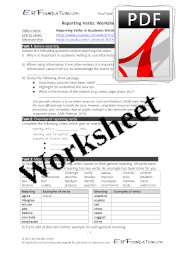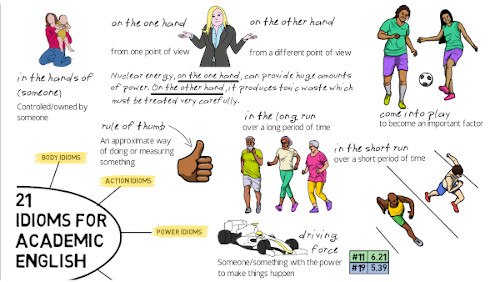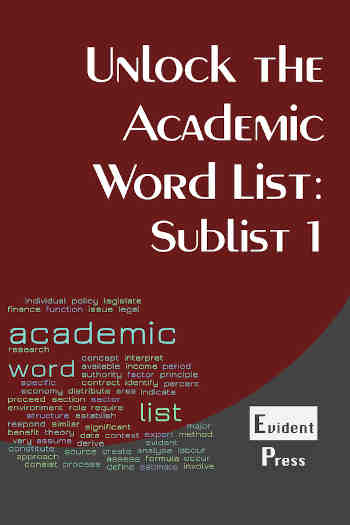Show AWL words on this page.
Show sorted lists of these words.


 







|
 Podcast is loading. Too slow? Click here to access.
Podcast is loading. Too slow? Click here to access.
Although it is often assumed that idioms are too informal for use in academic English, two studies have identified idioms which occur fairly frequently in spoken and written academic English.
This page describes idioms in academic English, giving information on what an idiom is, why academic idioms should be studied, as well as a list of academic idioms for spoken and written English from a recent study of idioms (Miller, 2019), giving first background to the creation of the list and finally the list itself.
There are also some exercises to help you practise using academic idioms.
 For a different look at the some of the idioms, check out the
academic idioms infographics ».
For a different look at the some of the idioms, check out the
academic idioms infographics ».
What is an idiom?

For another look at the same content, check out the video on YouTube (also available on Youku). There is a worksheet (with answers and teacher's notes) for this video.
An idiom is a fixed, well-established, multi-word expression, the meaning of which is not deducible from the individual words. The following are some examples of idioms in everyday (not academic) English.
- Raining cats and dogs - raining very hard
- Break a leg - said before a performance, meaning 'good luck'
- Behind one's back - secretly
The following are some examples of idioms for academic English use (a complete list is given below).
- On the other hand - from another point of view (showing contrast)
- Bear in mind - think of something, especially as a warning
- The bottom line - the main or essential point
- Take on board - accept or deal with (a problem or idea)
Why study academic idioms?
Idioms are common in everyday spoken and written English. Although it is often assumed that idioms are too informal for use in academic English, two studies (Simpson and Mendis, 2003, and Miller, 2019) have identified idioms which are used in academic contexts, more commonly in spoken academic contexts though also in academic writing. In Miller's study, idioms in spoken academic texts, including repetitions, occurred with a frequency of 835 per million words, or close to 0.1%. While this figure is not as high as, say, words in the Academic Word List (10%) or the Academic Collocation List (1.4%), productive knowledge of idioms will assist students in becoming part of the academic discourse community, while receptive knowledge will aid them in understanding spoken or written texts.
Miller reports that idioms may sometimes be signposted by lecturers (e.g. via the phrase as it were) or writers (e.g. via the phrase as they say or by use of quotation marks). However, these methods do not always signal idiom use, do not help students to understand the meaning of idioms, and in fact add a layer of complexity to academic English study (in terms of what as it were and as they say mean and why quotation marks are used in that way).
Academic Idioms List: background to the list
The list of academic idioms (below) comes from the study by Julia Miller (2019), which used two academic English corpuses: the British Academic Spoken English (BASE) corpus for spoken texts (lectures and seminars), and the Oxford Corpus of Academic English (OCAE) for written texts. Only idioms with a frequency of more than 1.2 per million words (pmw) in the BASE were included.
The range of idiom use is shown by the number of texts in which each idiom occurs, as well as the number of faculties (i.e. disciplinary groups) it occurs in. Miller's study used four such faculties, namely Social Sciences (which had the highest idiom use with 234 pmw), Arts and Humanities (which had 191 idioms pmw), Life and Medical Sciences (183 pmw), and Physical Sciences (which had the least frequent use, 76 pmw).
Most idioms in the list occur in more than one faculty, meaning they are suitable for study by all students of academic English. The most frequent idiom used in only one faculty, gold standard (24th most frequent idiom in spoken academic English and 10th most frequent in written academic English), was used only in the Life Sciences (medical articles).
References
Miller, J. (2019) 'The bottom line: Are idioms used in English academic speech and writing?', Journal of English for Academic Purposes, 43 (2020) 100810. Available online at: https://doi.org/10.1016/j.jeap.2019.100810.
Simpson, R., and Mendis, D. (2003) 'A corpus-based study of idioms in academic speech', Tesol Quarterly, 37(3), 419e441. Available online at: https://deepblue.lib.umich.edu/bitstream/handle/2027.42/90255/3588398.pdf?sequence=1.
Exercises
Academic Idioms List: Spoken
The list below gives spoken academic idioms from the BASE (British Academic Spoken English) corpus, listed in order of frequency. There are 170 idioms in total. There is a separate version of 38 idioms for written academic English (use the button below to switch lists). Definitions are included for all idioms. [Note: Sp freq pmw means spoken frequency per million words while Wr freq pmw refers to written frequency per million words.]
| No. | Idiom | Definition | Sp freq pmw (BASE) | Wr freq pmw (OCAE) | No. texts | No. faculties |
| 1 | on the other hand | adv (contrastive) from another point of view. [Syn: then again, but then] | 64.11 | 88.12 | 30 | 4 |
| 2 | bear in mind | verb (1) keep in mind. [Syn: mind] (2) think of something, especially as a warning. | 46.73 | 10.17 | 42 | 4 |
| 3 | on the one hand | adv from one point of view. [Syn: on one hand] | 37.74 | 31.87 | 30 | 4 |
| 4 | at the end of the day | adv taking everything into consideration. | 14.98 | 1.36 | 13 | 4 |
| 5 | the balance of power | noun an equilibrium of power between nations. | 10.78 | 6.20 | 8 | 2 |
| 6 | on the other [hand] | adv (contrastive) from another point of view. [Syn: then again, but then] | 10.19 | 20.34 | 12 | 3 |
| 7 | the bottom line | noun the main or essential point. | 8.39 | 2.50 | 8 | 4 |
| 8 | take on board | verb to understand or accept or deal with an idea. | 7.79 | 0.00 | 13 | 4 |
| 9 | by and large | adv usually; as a rule. [Syn: generally, more often than not, mostly] | 7.19 | 0.04 | 12 | 4 |
| 10 | a step further/back | noun action that will be helpful/harmful to a situation. | 7.19 | 6.21 | 12 | 4 |
| 11 | take for granted | verb (1) take to be the case or to be true; accept without verification or proof. [Syn: assume, presume] (2) value too lightly. | 7.19 | 0.01 | 9 | 3 |
| 12 | in the hands of | adv controlled or owned by someone. | 6.59 | 12.54 | 10 | 3 |
| 13 | along the lines of | adv in a similar way or of a similar type. | 6.59 | 9.24 | 9 | 3 |
| 14 | in its own right | adv because of its own special qualities. | 5.99 | 9.27 | 10 | 4 |
| 15 | across the board | adv including or applying to all. | 5.99 | 1.21 | 7 | 3 |
| 16 | at the back of one's mind | adv in the part of one's mind where memories are kept but not usually thought about. | 5.99 | 0.30 | 4 | 2 |
| 17 | sit on the fence | verb to be unwilling or unable to make a decision. | 5.99 | 0.12 | 2 | 2 |
| 18 | in the long run | adv after a very lengthy period of time. [Syn: in the end] | 5.39 | 7.84 | 9 | 4 |
| 19 | bad news | noun someone or something that is undesirable or dangerous. | 5.39 | 2.75 | 8 | 4 |
| 20 | driving force | noun someone or something that makes something happen. | 5.39 | 6.21 | 8 | 4 |
| 21 | on the face of it | adv from appearances alone. [Syn: apparently, seemingly, ostensibly] | 5.39 | 2.57 | 8 | 4 |
| 22 | in (the) light of | adv in view of, because of, considering. | 5.39 | 34.99 | 8 | 3 |
| 23 | come into play | verb begin to be used or begin to have an effect. | 5.39 | 4.26 | 8 | 3 |
| 24 | gold standard | noun (1) a monetary standard under which the basic unit of currency is defined by a stated quantity of gold. (2) a paragon of excellence. | 5.39 | 6.66 | 6 | 1 |
| 25 | what on earth | adj used to show surprise, confusion, or anger (at what has happened or is happening). | 4.79 | 0.17 | 7 | 3 |
| 26 | go without saying | verb to be so obvious that it does not need explanation. | 4.79 | 1.85 | 6 | 2 |
| 27 | trial and error | noun experimenting until a solution is found. | 4.79 | 1.85 | 5 | 3 |
| 28 | down the line | adv in the future. | 4.19 | 0.08 | 7 | 3 |
| 29 | over the top | adj too extreme, or demanding too much attention. | 4.19 | 0.05 | 6 | 3 |
| 30 | state of the art | noun the highest degree of development of an art or technique at a particular time. | 4.19 | 1.36 | 4 | 2 |
| 31 | the man/woman in the street | noun an average person whose opinions are considered to be representative of most people. | 4.19 | 0.28 | 3 | 3 |
| 32 | stepping stone | noun (1) a stone in a marsh or shallow water that can be stepped on in crossing. (2) any means of advancement. | 4.19 | 0.66 | 2 | 1 |
| 33 | from scratch | adv from the beginning. | 3.59 | 1.86 | 6 | 3 |
| 34 | bridge the gap | verb to connect two things or make the difference between them smaller. | 3.59 | 1.85 | 6 | 3 |
| 35 | the big picture | noun the whole story or idea. | 3.59 | 1.30 | 6 | 3 |
| 36 | in the early days | noun an early period of development. [Syn: youth] | 3.59 | 2.33 | 5 | 4 |
| 37 | get one's head (a) round | verb to understand something (often used in the negative). | 3.59 | 0.02 | 5 | 4 |
| 38 | go hand in hand with | verb be closely related to or happening at the same tim. | 3.59 | 2.68 | 5 | 3 |
| 39 | keep an eye on | verb follow with the eyes or the mind. [Syn: watch, observe, follow, watch over] | 3.59 | 0.78 | 5 | 3 |
| 40 | hang on a minute | verb used to tell someone to wait for a brief time. | 3.59 | 0.04 | 5 | 2 |
| 41 | on the spot | adv (1) without delay or immediately. (2) in a difficult situation. (3) at the place in question; there. | 3.59 | 0.84 | 4 | 4 |
| 42 | get to grips with | verb deal with (a problem or a subject). [Syn: come to grips] | 3.59 | 1.78 | 4 | 3 |
| 43 | go through the roof | verb (1) to rise to a very high level. (2) to react angrily. | 3.59 | 0.06 | 4 | 2 |
| 44 | full circle | adv returning to the original place, source, or state after a cycle of developments (esp. in the phrase to come full circle). | 3.00 | 0.54 | 5 | 3 |
| 45 | that's another story | noun used for something that you do not want to give more detail about at this time. | 3.00 | 0.27 | 5 | 3 |
| 46 | how on earth | adv use to show surprise, confusion, or anger (at how something happened or is happening). | 3.00 | 0.08 | 5 | 3 |
| 47 | cast one's mind back | verb to try to remember. | 3.00 | 0.04 | 5 | 3 |
| 48 | last resort | noun (1) French for `worst going'. [Syn: pis aller] (2) the only choice that remains after all others hand been tried. | 3.00 | 4.05 | 5 | 2 |
| 49 | the other side of the coin | noun a different way of considering a situation (either better or worse). | 3.00 | 0.54 | 5 | 2 |
| 50 | ring a bell | verb to sound familiar. | 3.00 | 0.15 | 5 | 1 |
| 51 | good old days | noun a time in the past when life seemed to be much better. | 3.00 | 0.27 | 4 | 3 |
| 52 | grey area | noun an intermediate area; a topic that is not clearly one thing or the other. [Syn: gray area] | 3.00 | 0.60 | 4 | 2 |
| 53 | out of the blue | adj not anticipated. [Syn: unanticipated, unforeseen, unlooked-for] adv in a way that was not expected. [Syn: unexpectedly] | 3.00 | 0.05 | 3 | 3 |
| 54 | golden age | noun (1) a time period when some activity or skill was at its peak. (2) any period (sometimes imaginary) of great peace and prosperity and happiness. (3) (classical mythology) the first and best age of the world, a time of ideal happiness, prosperity, and innocence; by extension, any flourishing and outstanding period. [Syn: Golden Age] | 3.00 | 2.96 | 3 | 2 |
| 55 | touchy-feely | adj (often derogatory) openly expressing love and affection (especially through physical contact). | 3.00 | 0.05 | 3 | 1 |
| 56 | in the short run | adv over a relatively brief period of time (often used in contrast with the long run) . | 3.00 | 4.19 | 2 | 2 |
| 57 | spring to mind | verb be remembered. [Syn: come to mind] | 2.40 | 0.31 | 4 | 3 |
| 58 | on the right track | adv doing something in a way that is likely to lead to success. | 2.40 | 0.28 | 4 | 3 |
| 59 | have a stab at | verb to try to do something, though you are unlikely to be successful. | 2.40 | 0.25 | 4 | 3 |
| 60 | get the picture | verb get the meaning of something. [Syn: comprehend, savvy, dig, grasp, compass, apprehend] | 2.40 | 0.08 | 4 | 3 |
| 61 | the high point | noun the best or most enjoyable part of a given experience. | 2.40 | 1.52 | 4 | 2 |
| 62 | it's early days | noun to be too soon to make a judgement about something because there is still a lot of time for things to change. | 2.40 | 0.01 | 4 | 2 |
| 63 | the whole story | noun all the facts. | 2.40 | 1.41 | 3 | 3 |
| 64 | do the job | verb to serve a particular purpose (though it may not be the best thing to use). | 2.40 | 0.63 | 3 | 3 |
| 65 | move the goalposts | verb to change the rules during an activity to make it more difficult for other people involved. | 2.40 | 0.08 | 3 | 3 |
| 66 | behind the scenes | adv happening without people knowing it, especially when something else is happening publicly. | 2.40 | 1.36 | 3 | 2 |
| 67 | in the pipeline | adj in progress. | 2.40 | 0.31 | 3 | 2 |
| 68 | on the back burner | adj having low priority. | 2.40 | 0.11 | 3 | 2 |
| 69 | bog standard | adj having no special or interesting qualities. | 2.40 | 0.02 | 3 | 2 |
| 70 | out of one's hands | adj not in someone's control. | 2.40 | 0.00 | 3 | 2 |
| 71 | call the cavalry | verb request back-up or a special team to solve a problem. | 2.40 | 0.00 | 3 | 2 |
| 72 | beg the question | verb (1) to cause someone to ask a particular question. (2) to talk about something as if it were true, even though it may not be. | 2.40 | 2.18 | 2 | 2 |
| 73 | get something straight | verb to understand what is true. | 2.40 | 0.05 | 2 | 2 |
| 74 | play ball | verb to agree to work with someone in the way they want. | 2.40 | 0.05 | 2 | 1 |
| 75 | boil down to | verb (1) be the essential element. [Syn: reduce, come down] (2) be cooked until very little liquid is left. [Syn: reduce, decoct, concentrate] (3) cook until very little liquid is left. [Syn: reduce, concentrate] | 1.80 | 1.13 | 3 | 3 |
| 76 | in store | adj in readiness; awaiting. | 1.80 | 0.34 | 3 | 3 |
| 77 | make up one's own mind | verb to make a decision about something. | 1.80 | 0.20 | 3 | 3 |
| 78 | have up one's sleeve | verb to have a secret plan or idea that can be used when needed. | 1.80 | 0.12 | 3 | 3 |
| 79 | go down that route | verb to pursue a particular course of action (often negative). | 1.80 | 0.09 | 3 | 3 |
| 80 | get one's act together | verb to organise oneself in order to do things in a more effective way. | 1.80 | 0.08 | 3 | 3 |
| 81 | on one hand | adv from one point of view. [Syn: on the one hand] | 1.80 | 2.58 | 3 | 2 |
| 82 | overall picture | noun a complete view of a subject. | 1.80 | 1.14 | 3 | 2 |
| 83 | golden rule | noun (1) any important rule. (2) a command based on Jesus' words in the Sermon on the Mount. [Syn: Golden Rule] | 1.80 | 1.05 | 3 | 2 |
| 84 | have a life of its own | verb to move or function without a person touching it. | 1.80 | 0.89 | 3 | 2 |
| 85 | turn something on its head | verb to cause something to be the opposite of what it was before. | 1.80 | 0.76 | 3 | 2 |
| 86 | fall into place | verb become clear or enter one's consciousness or emotions. [Syn: click, get through, dawn, come home, get across, sink in, penetrate] | 1.80 | 0.30 | 3 | 2 |
| 87 | so far so good | adj used for an activity that has gone well up to now. | 1.80 | 0.23 | 3 | 2 |
| 88 | on one's hands | adj imposed on someone (a responsibility). | 1.80 | 0.11 | 3 | 2 |
| 89 | in the same boat | adj in the same difficult situation as others. | 1.80 | 0.09 | 3 | 2 |
| 90 | take home message | noun the main piece of information that is learnt from something. | 1.80 | 0.11 | 3 | 1 |
| 91 | joe public | noun the general public. | 1.80 | 0.04 | 3 | 1 |
| 92 | kicking and screaming | adj used to describe someone who has been forced to go somewhere or do something, despite much protest. | 1.80 | 0.02 | 3 | 1 |
| 93 | rule of thumb | noun a rule or principle that provides guidance to appropriate behavior. [Syn: guidepost, guideline] | 1.20 | 2.98 | 2 | 2 |
| 94 | hot spots | noun (1) a place of political unrest and potential violence. [Syn: hotspot] (2) a point of intense heat or radiation. [Syn: hotspot] (3) a lively entertainment spot. [Syn: hotspot] | 1.80 | 0.94 | 2 | 2 |
| 95 | ring true | verb to seem to be true. | 1.80 | 0.30 | 2 | 2 |
| 96 | put your finger on | verb to recognise the reason behind a situation (especially when something is wrong). | 1.80 | 0.24 | 2 | 2 |
| 97 | get a handle on | verb to have an understanding of something. | 1.80 | 0.21 | 2 | 2 |
| 98 | shut up shop | verb to end an activity (especially business activity). | 1.80 | 0.01 | 2 | 2 |
| 99 | set something in stone | verb to be permanent or very difficult to change. | 1.80 | 0.12 | 2 | 1 |
| 100 | swings and roundabouts | noun a situation in which the positive and negatives balance each other. | 1.80 | 0.02 | 2 | 1 |
| 101 | go in one ear and out the other | verb to quickly forget something. | 1.80 | 0.00 | 2 | 1 |
| 102 | in a nutshell | adv summed up briefly. | 1.20 | 1.17 | 2 | 2 |
| 103 | fall foul of | verb to break a rule or law without intending to. | 1.20 | 1.15 | 2 | 2 |
| 104 | set the scene | verb (1) to describe a situation that is about to happen. (2) to make something likely to happen later. | 1.20 | 1.15 | 2 | 2 |
| 105 | have the upper hand | verb to have a position of advantage and control. | 1.20 | 0.88 | 2 | 2 |
| 106 | on the side | adv without official authorization. [Syn: unofficially] | 1.20 | 0.84 | 2 | 2 |
| 107 | make up one's mind | verb to decide. | 1.20 | 0.76 | 2 | 2 |
| 108 | fly in the face of | verb go against. [Syn: fly in the teeth of] | 1.20 | 0.71 | 2 | 2 |
| 109 | get carried away | verb to become so excited that you cannot control what you do or say. | 1.20 | 0.65 | 2 | 2 |
| 110 | moot point | noun a fact or claim that does not matter. | 1.20 | 0.47 | 2 | 2 |
| 111 | someone's bread and butter | noun the job someone does to earn an income. | 1.20 | 0.38 | 2 | 2 |
| 112 | stand to reason | verb to be the logical conclusion. | 1.20 | 0.38 | 2 | 2 |
| 113 | devil's advocate | noun someone who pretends to be against a plan or idea in order to get others to discuss it in more detail. | 1.20 | 0.37 | 2 | 2 |
| 114 | get one's message across | verb to make someone understand. | 1.20 | 0.30 | 2 | 2 |
| 115 | deliver the goods | verb attain success or reach a desired goal. [Syn: succeed, win, come through, bring home the bacon] | 1.20 | 0.23 | 2 | 2 |
| 116 | a bad press | noun to be criticised (especially in the media). | 1.20 | 0.19 | 2 | 2 |
| 117 | the powers that be | noun important people who have power or control over others. | 1.20 | 0.18 | 2 | 2 |
| 118 | set foot in | verb to enter (a location). | 1.20 | 0.14 | 2 | 2 |
| 119 | happily ever after | adv used to suggest that things will work out perfectly in future. | 1.20 | 0.11 | 2 | 2 |
| 120 | shift gears | verb to suddenly change what you are doing or discussing. | 1.20 | 0.11 | 2 | 2 |
| 121 | get down to the nitty gritty | verb to focus on the most important aspects of a situation. | 1.20 | 0.09 | 2 | 2 |
| 122 | in one's sights | adj the focus of someone's attention and desire for possession. | 1.20 | 0.08 | 2 | 2 |
| 123 | brain power | noun intelligence, ability to think. | 1.20 | 0.07 | 2 | 2 |
| 124 | not to mince one's words | verb not to soften the effect of one's words. | 1.20 | 0.06 | 2 | 2 |
| 125 | throw somebody in at the deep end | verb to make somebody do something new and difficult without help or preparation. | 1.20 | 0.06 | 2 | 2 |
| 126 | cover one's bases | verb to make sure something is successful by trying to anticipate and deal with all problems first. | 1.20 | 0.06 | 2 | 2 |
| 127 | weird and wonderful | adj have unusual appearance or design. | 1.20 | 0.06 | 2 | 2 |
| 128 | cast an eye over | verb to take a quick look at something. | 1.20 | 0.06 | 2 | 2 |
| 129 | above one's station | adj higher than is suitable according to a person's position or rank. | 1.20 | 0.05 | 2 | 2 |
| 130 | have a go | verb make an attempt at something. [Syn: give it a try] | 1.20 | 0.02 | 2 | 2 |
| 131 | in the same ballpark | adj of a similar amount or cost. | 1.20 | 0.02 | 2 | 2 |
| 132 | pat on the back | noun praise for something well done. verb to praise someone for something well done. | 1.20 | 0.02 | 2 | 2 |
| 133 | sit on one's hands | verb to do nothing about a problem that needs dealing with. | 1.20 | 0.02 | 2 | 2 |
| 134 | throw up one's hands | verb to give up, especially in frustration. | 1.20 | 0.02 | 2 | 2 |
| 135 | watch this space | verb to pay attention, as something will happen soon. | 1.20 | 0.02 | 2 | 2 |
| 136 | go down the road of | verb to follow a similar course of action to (somebody/something). | 1.20 | 0.01 | 2 | 2 |
| 137 | this that and the other | noun a lot of different, varying things. | 1.20 | 0.01 | 2 | 2 |
| 138 | get cracking | verb start to be active. [Syn: bestir oneself, get going, get moving, get weaving, get started, get rolling] | 1.20 | 0.01 | 2 | 2 |
| 139 | give someone a shout | verb to contact someone to alert them to something. | 1.20 | 0.01 | 2 | 2 |
| 140 | have a crack at | verb to attempt something. | 1.20 | 0.01 | 2 | 2 |
| 141 | not to put too fine a point on it | verb to be completely direct. | 1.20 | 0.01 | 2 | 2 |
| 142 | give the game away | verb to spoil a surprise by giving away something secret. | 1.20 | 0.01 | 2 | 2 |
| 143 | beat/get the hell out of something | verb to defeat decisively (beat the hell out of), to leave as quickly as possible (get the hell out of). | 1.20 | 0.00 | 2 | 2 |
| 144 | get a move on | verb to move or work faster, to hurry. | 1.20 | 0.00 | 2 | 2 |
| 145 | get one's thoughts together | verb to organise one's thoughts, especially to regain one's calm. | 1.20 | 0.00 | 2 | 2 |
| 146 | hand on heart | adv giving assurance that what one is saying is completely truthful. | 1.20 | 0.00 | 2 | 2 |
| 147 | quote somebody on something | verb tell other people that someone said something. | 1.20 | 0.00 | 2 | 2 |
| 148 | put one's head above the parapet | verb to take a risk (by saying something that may receive an unfavourable response). | 1.20 | 0.00 | 2 | 2 |
| 149 | a fair share | noun a reasonable amount. | 1.20 | 1.55 | 2 | 1 |
| 150 | to say the least | verb to put it mildly (used to indicate that what you have described is much more serious than suggested). | 1.20 | 1.10 | 2 | 1 |
| 151 | grass roots movement | noun an organized effort made by ordinary individuals, not leaders. | 1.20 | 0.65 | 2 | 1 |
| 152 | pick and choose | verb to only take things you want. | 1.20 | 0.47 | 2 | 1 |
| 153 | sow seeds of thought | verb to cause someone to think about something (in the future). | 1.20 | 0.37 | 2 | 1 |
| 154 | at loggerheads | adj in a dispute or confrontation. | 1.20 | 0.24 | 2 | 1 |
| 155 | drag one's feet | verb to do something slowly (or not start to do it) because you do not want to do it. | 1.20 | 0.21 | 2 | 1 |
| 156 | in the driving seat | adj in control of a situation. | 1.20 | 0.17 | 2 | 1 |
| 157 | go back to square one | verb to start a new course of action from the beginning because the original course failed. | 1.20 | 0.08 | 2 | 1 |
| 158 | set in tablets of stone | verb to be very difficult or impossible to change. | 1.20 | 0.07 | 2 | 1 |
| 159 | dear to one's heart | adj personally important. | 1.20 | 0.06 | 2 | 1 |
| 160 | off the top of one's head | adv from memory. | 1.20 | 0.05 | 2 | 1 |
| 161 | end of story | noun said when you think your opinion is correct and there is no other way of thinking about it . | 1.20 | 0.05 | 2 | 1 |
| 162 | in a rut | adj fixed in a particular job or activity and needing a change. | 1.20 | 0.04 | 2 | 1 |
| 163 | tick the boxes | verb to satisfy everything that is required. | 1.20 | 0.04 | 2 | 1 |
| 164 | round robin | noun (1) a tournament in which every contestant plays every other contestant. (2) a letter signed by a number of people. | 1.20 | 0.02 | 2 | 1 |
| 165 | dig one's heels in | verb to refuse to change your idea, especially when someone is trying to persuade you to change. | 1.20 | 0.02 | 2 | 1 |
| 166 | stretch one's legs | verb to go for a walk. | 1.20 | 0.02 | 2 | 1 |
| 167 | get someone on board | verb to get someone's support. | 1.20 | 0.00 | 2 | 1 |
| 168 | on that note | adv used to transition from one topic to the next. | 1.20 | 0.00 | 2 | 1 |
| 169 | tail end Charlie | noun a person at the rear of a formation. | 1.20 | 0.00 | 2 | 1 |
| 170 | jump up and down | verb to make a great display of emotion (especially anger or excitement). | 1.20 | 0.00 | 2 | 1 |
Some definitions take from WordNet 3.0 Copyright 2006 by Princeton University. All rights reserved. THIS SOFTWARE AND DATABASE IS PROVIDED "AS IS" AND PRINCETON UNIVERSITY MAKES NO REPRESENTATIONS OR WARRANTIES, EXPRESS OR IMPLIED. BY WAY OF EXAMPLE, BUT NOT LIMITATION, PRINCETON UNIVERSITY MAKES NO REPRESENTATIONS OR WARRANTIES OF MERCHANT- ABILITY OR FITNESS FOR ANY PARTICULAR PURPOSE OR THAT THE USE OF THE LICENSED SOFTWARE, DATABASE OR DOCUMENTATION WILL NOT INFRINGE ANY THIRD PARTY PATENTS, COPYRIGHTS, TRADEMARKS OR OTHER RIGHTS.






